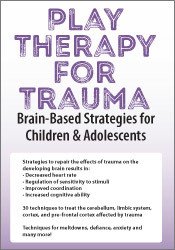

Techniques to repair the brain and improve:
Are you struggling to find creative, effective, brain-based techniques to help your kids who suffer from anxiety, impulsivity, isolation and defiance as a result of trauma?
Join Amy Flaherty, to discover innovative brain-based techniques, such as sandtray, art, and movement exercises to use in the play room to increase cognitive ability, regulate sensitivity to stimuli, and improve coordination. You will leave with confidence to design, tailor, and apply play therapy techniques using the backing of solid neuroscience.
Learn to recognize trauma loops, dysregulation, regression, rigidity in your clients, and discover countless and effective play therapy techniques to heal them. Take advantage of the latest brain-research to effectively treat common trauma-related behaviors, such as:
Videos, case studies, and experiential techniques will be used to fully explain play therapy techniques and the latest brain research.
This online program is worth 6.25 hours CPD.
| File type | File name | Number of pages | |
|---|---|---|---|
| Manual (1.79 MB) | 37 Pages | Available after Purchase |
Amy Flaherty is a Licensed Psychological Examiner-Independent, and a RPT in Northeast Arkansas. She has been working with children as well as adults in the outpatient counseling setting for over 10 years. Amy taught intensive play therapy classes for the past several years. In addition to the 150 hours of classes she completed to earn her play therapy credential, she also studied under Theresa Kestly at the Sandtray Institute of New Mexico, completing over 100 hours of intensive study of how the brain works in sandtray and play therapy. Amy blogs and speaks regularly about all things sandtray and play therapy and was featured on the website of the Association of Play Therapy for her work with Pam Dyson of the DFW Center for Play Therapy. Amy is a dynamic, interactive speaker, weaving real life case studies with brain-informed research to provide an overall understanding of play therapy.
Speaker Disclosures:
Financial: Amy Flaherty is President of True Hope Counseling, PLLC. She is also the founder and director of the Southern Sandtray Institute. She receives a speaking honorarium from PESI, Inc. She has no relevant financial relationships with ineligible organizations.
Non-financial: Amy Flaherty is a member of the Association of Play Therapy and the Arkansas Association of Play Therapy.
Overview of the Effect of Trauma on the Brain
Principles of Interpersonal Neurobiology in Play Therapy
REPAIRING THE BRAIN THROUGH PLAY TECHNIQUES – OVER 30 TECHNIQUES
Techniques for dysregulation, rigidity, regression, trauma loops (targets cerebellum)
Techniques for emotional identification (targets the limbic system)
Techniques for coping skills to address rigidity, trauma loops, and harmful behaviors (targets the cortex)
Techniques to improve executive function for positive choices: After body is regulated and the whole brain is online (targets the pre-frontal cortex)
Best practices for parents/caregivers
| 5 |
|
| 4 |
|
| 3 |
|
| 2 |
|
| 1 |
|
Satisfaction Guarantee
Your satisfaction is our goal and our guarantee. Concerns should be addressed to info@pesi.co.uk or call 01235847393.
Please wait ...